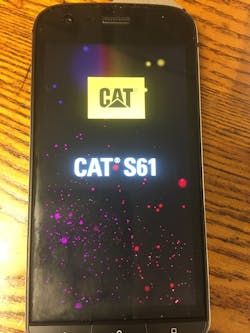Cat S61 Smartphone Adds Indoor Air Quality Sensor, Distance Measurement
The first noticeable thing about the Cat S61 rugged smartphone is its heft.
It feels thick and substantial, without the benefit of the ubiquitous Otterbox or Lifeproof cases that protect many consumer smartphones.
The rugged and “ultra rugged” markets are growing; they combined to sell more than 22 million units worldwide in 2017, says a report from Bullitt Research Group that uses data compiled by CCS Insight and YouGov. In the next four years, the report concludes, the number is expected to grow beyond 54 million units.
The reason, according to the report, is a high incidence of phone damage among users involved in construction, mining and quarrying, agriculture, engineering, and manufacturing—activities in which 42 percent of phone users report damaging their phones at some point in the past three years. (Full disclosure: The Bullitt Research Group is an arm of the Bullitt Group, the U.K.-based maker of the Android-based Cat phones.)
So with the growth potential and the amount of phone damage inherent in the markets mentioned above, it’s no surprise that Cat is “all in” on the category, which also includes the likes of Kyocera, Panasonic, Sonim, and Blackview.
As is expected in the rugged/ultra-rugged smartphone category, the company has done its due diligence. S61 testing included 26 drops from 1.8 meters on to concrete, and the phone is fully dustproof and waterproof to 5 meters down. It has also endured testing in hot and cold environments, immediately being taken from one to the other and expected to work.
It also works nicely after a tumble down a flight of stairs. The smartphone’s rugged credibility is not in question.
And assuming that the basics, such as signal quality, sound quality, ergonomics, and a camera that’s competitive versus the rest of the market are relatively equal, the focus should be on the “extras;” the major features Cat has added going from the S60 to the S61.
That’s an indoor air quality sensor and a laser-assisted distance meter, both customer-requested features, according to Bullitt. The device maker says it talked to 50,000 Cat phone users in preparation for the S61.
The indoor air quality sensor is designed to measure VOCs or Volatile Organic Compounds. Items such as cleaning agents, paint, solvents, building materials, and glue can generate VOCs. The phone samples the air every four seconds to give the user an “awareness perspective,” Bullitt says. If the air is at an unhealthy level, the phone will alert the user.
This could come in handy in shops or enclosed situations. It also reports temperature and humidity levels without having to go to the thermal imaging camera.
Temperature and humidity testing proved accurate, though the device was slow to update readings when going from indoors to outdoors and vice versa. The thermometer/sensor set in a moving car seems to update faster.
Though the parts-per-billion air sample data never found anything but “excellent” air during evaluation (with the exception of the mouth of a bottle of household bleach), its levels are easy to read, and color-coded from green to light green to yellow to orange to red, or Excellent to Good, Moderate, Poor, and Unhealthy, respectively. Notifications may be set for Poor and Unhealthy.
The S61 has the ability to keep and compare these measurements.
The laser-assisted distance-measuring feature comes with a fairly in-depth tutorial screen, which is more than you get with Apple’s distance measuring app (iOS 12 and later).
Its use is a confusing affair at best, less than intuitive—it’s not job worthy, or Jobs worthy. The best thing about the Apple app is that it comes with a built-in level.
The Cat phone has a Class 2 laser, which new users have to calibrate in order to use. Calibration is relatively easy, but it does involve hanging the unit off a table and then finding a tape measure to manually measure (and enter) the distance between the phone and the laser point on the floor.
It’s fairly accurate in actual use, and very handy for a quick-and-dirty estimate of distance. Here’s how it works: The laser projects a dot on an object at distance (up to 8 meters). The user then takes a photo of the image with the rear camera. The distance between the phone and the surface is then displayed next to the image.
Even after being set to inches during calibration, for some reason the unit kept reverting to centimeters when displaying measurements.
Disclaimers make sure the user knows that the air quality readings and distance measurements are not meant to take the place of official health measurements or precision measuring devices, respectively, but in all, the two new tools are easy to work with—and handy items for the shop and job site wrapped in a heavy-duty Cat-branded package.
